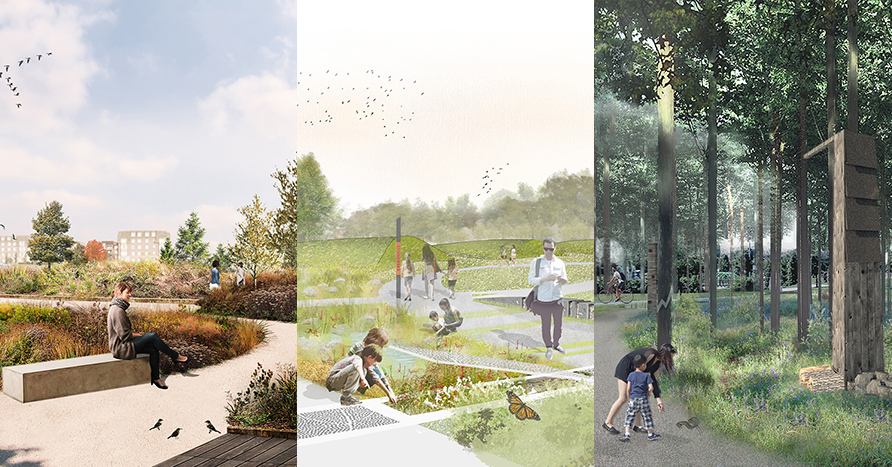This project competition is:
• a multidisciplinary landscape architecture competition;
• national in scope;
• held in two stages: the first consisting of anonymous proposals, the second consisting of service offerings prepared by four jury-selected finalists.
(From website)
With an industrial park covering approximately 70% of its territory, Saint-Laurent is one of the boroughs with the most significant heat islands in the Montreal area. Habitats conducive to biodiversity are fragmented by barriers such as highways 40 and 13, the major boulevards Cavendish, Henri-Bourassa, and Thimens, as well as residential, commercial, and industrial developments.
[...]
The borough of Saint-Laurent aims to develop the Cavendish-Laurin-Liesse biodiversity corridor. To this end, a master development plan will be drawn up to define the orientations and interventions to be prioritized for the implementation of the corridor on the territory.
Situated at the crossroads of natural and urbanized environments, the corridor project calls on a variety of disciplines and will contribute to the conservation of environments of interest and the protection of biodiversity, notably through interventions to improve wildlife habitat and increase vegetation cover, in addition to offering residents various routes that will become both recreational destinations for outdoor activities and physical exercise, and connections with the borough's various hubs, cultural attractions and living environments.
Ecological connectivity is an essential quality of a biodiversity corridor, ensuring "the maintenance of biodiversity [...] by enabling species to disperse and migrate". It consists in linking landscape elements (natural environments, green spaces, islands of greenery, etc.) together, to enable wildlife species to carry out all or part of their life cycle. A biodiversity corridor is therefore made up of one or more natural infrastructures that establish a better connection between fragmented habitats and natural environments in the area. This connection can be aerial (non-continuous islands of greenery for birds or insects, for example) or terrestrial (continuous links and wildlife passages for foxes or amphibians, for example). Restoring ecological links is just as important as protecting existing natural environments, not only to ensure that populations are maintained, but also to ensure genetic exchange between them.
Thus, the creation of the Cavendish-Laurin-Liesse biodiversity corridor aims to meet two general objectives:
- To consolidate the biodiversity corridor's environmental, social and cultural assets;
- Connect these assets to create ecological connections and citizen trails.
(From competition program)
(Unofficial automated translation)
Stage 1
The jury evaluated the project using the following criteria. The criteria relate to the issues and challenges specific to the project and are judged on an equivalent basis.
Ecological qualities: The anticipated beneficial effects of the interventions and the proposal's ability to promote biodiversity and ecological connectivity.
Formal and landscape qualities: The quality of the overall concept; integration with the existing landscape and built environment.
Experiential and perceptual qualities: The quality of the ambience and experiences proposed; the quality and diversity of the citizens' pathways.
Social and cultural qualities: the potential for appropriation of the places created; the potential for interaction and education for local residents, workers and visitors.
Stage 2
For stage 2 of the competition, the evaluation criteria are the same as for stage 1, with the addition of new elements:
Ecological qualities: The anticipated beneficial effects of the interventions on the quality of biodiversity and ecological connectivity; the comfort of the site for users under different climatic conditions.
Formal and landscape qualities: the quality of the overall concept; integration with the existing landscape and built environment; choice and sensitive integration of materials, structures and planting.
Experiential and perceptual qualities: The quality of the ambiences and experiences proposed; the quality and diversity of the citizen pathways; the creation of a strong, recognizable signature for the project throughout the area.
Social and cultural qualities: The potential for appropriation of the places created; the potential for interaction and education for local residents, workers and visitors.
Feasibility: The likelihood of fully respecting the limits of the Project in terms of allocated resources (human and budgetary), established deadlines and site constraints.
Qualification of the Team to carry out the mandate: Experience and expertise of the Landscape Architect or Firm of Landscape Architects (30%); Experience and expertise of the expert in biology/ecology (25%); Relevance of previous projects presented (25%); Organization of the Team (20%).
(From jury report)
(Consult the competitors' projects for specific comments from the jury)
(Unofficial automated translation)
| Jury president S1 |
Pierre Thibault, Architecte
|
| Jury S1 | Beaudoin Alexandre, Conseiller en biodiversité |
| | Jacinthe Daprato, Biologiste |
| | Kenza Diboune, Conseillère en aménagement |
| | Stéphanie Henry, Architecte paysagiste |
| | Louis-Charles Lasnier, Designer |
| | Caroline Magar, Conseillère en aménagement |
| | Claude Thiffault, Biologiste |
| |
|
| Jury president S2 |
Pierre Thibault, Architecte
|
| Jury S2 | Beaudoin Alexandre, Conseiller en biodiversité |
| | Jacinthe Daprato, Biologiste |
| | Kenza Diboune, Conseillère en aménagement |
| | Stéphanie Henry, Architecte paysagiste |
| | Louis-Charles Lasnier, Designer |
| | Caroline Magar, Conseillère en aménagement |
| | Claude Thiffault, Biologiste |
| |
|
| |
|
Stage 1/Call for Proposals
Announcement of the competition in the media: September 11, 2017
Availability of the Competition Documents on SEAO: September 11, 2017
Question and answer period: September 11 to October 25, 2017
Addenda transmission deadline: October 16, 2017
Submission of Proposals: November 6, 2017, noon, Montreal time
Jury meeting: November 13, 2017
Communication to the Finalists concerned of the selection of their candidacy: Week of November 13, 2017
Stage 2/Provisions
Submission of Team Completion Dossier: December 4, 2017, noon, Montreal time
Signing of Finalists' Professional Services Agreement (Appendix E) following approval by the authorities: Mid to late January 2018
Announcement of Finalists: Mid to late January 2018
Mandatory information meeting for Finalists: Mid to late January 2018
Question and answer period: From the signing of the Finalists' professional services agreement to March 9, 2018
Deadline for sending addendums: March 1, 2018
Submission of performances: March 22, 2018, noon, Montreal time
Submission of visual presentation in support of audition: April 2, 2018
Finalists' public audition and Jury: April 5 and 6, 2018
Announcement of winner: May or June 2018
(From competition brief)
(Unofficial automated translation)
Corridor de biodiversité à Saint-Laurent : les finalistes du concours d’architecture de paysage, Voir vert - Le portail du bâtiment durable au Québec, 2018
Pellus, Johanna, Corridor de biodiversité: dévoilement du lauréat du concours d'architecture de paysage, Journal Métro, 2018
Corridor de biodiversité de Saint-Laurent : l’équipe lauréate dévoilée, Portail constructo, 2018
Cyr, Chantal, Un Corridor de biodiversité pour Montréal, Fugues, 2020
Fritsch, Marc-Olivier, Corridor de biodiversité de Saint-Laurent : reconnecter l'humain à la nature!, CISION, 2019
- Programme
- Règlement
- Rapport du jury (global)











